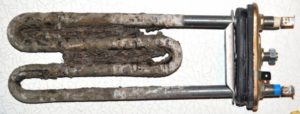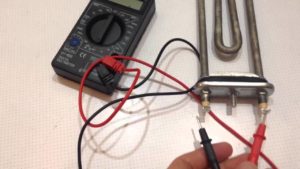Samsung washing machine does not heat water
 One of the malfunctions that often occurs when operating Samsung automatic machines is the inability to heat the water in the tank. There may be several reasons for this problem to arise. It is possible to deal with the true root cause of the breakdown on your own, without resorting to the help of a specialist. To do this, you need to familiarize yourself with the main factors that could lead to the fact that the Samsung machine does not heat the water.
One of the malfunctions that often occurs when operating Samsung automatic machines is the inability to heat the water in the tank. There may be several reasons for this problem to arise. It is possible to deal with the true root cause of the breakdown on your own, without resorting to the help of a specialist. To do this, you need to familiarize yourself with the main factors that could lead to the fact that the Samsung machine does not heat the water.
Typical causes of failure
Before you begin diagnostic steps to identify faults, you should once again make sure that the machine really washes with cold water. To do this, turn on any washing program (“Quick Wash”, “Cotton”, “Synthetics”, etc.) and after 15 minutes, touch the sunroof glass with your hand. The viewing window should be warm. If it is cold, then a breakdown still occurs.
What are the main reasons that can lead to such a situation? There are three typical factors.
- Incorrect mode selection. Samsung household appliances are equipped with a huge number of different programs and functions, and for each washing mode the manufacturer determines a specific water heating temperature. Therefore, before you panic, you should once again make sure that the program is selected correctly, and the set water temperature requires heating at all.

- Heating element malfunction. It is the breakdown of the heating element that probably causes the machine to not heat the water when washing. A tubular electric heater can fail due to the accumulation of plaque and scale on its surface, manufacturing defects, or improper operation of the heating element.To eliminate the defect, you need to remove the element from the washing machine body, check it using a multimeter and replace it if necessary.
- Damage to the water heating sensor. The purpose of the temperature sensor is to ensure timely switching on and off of the heating element. If it breaks, then the SMA simply will not heat the water. To diagnose the temperature sensor, remove it from the washing machine body and test the resistance of the element with a multimeter. Afterwards, the part is placed in water heated to 40-60 degrees for a few seconds and checked again with a multimeter. If the resistance value in the first and second cases differs significantly, it means that the heating sensor is functioning perfectly. If the numbers are approximately the same, you will have to replace this part.
Very rarely, a problem with water heating can be caused by a breakdown of the triac on the control board, which is responsible for the heating function. With this outcome, the intelligence of the machine does not activate heating at all, or this process proceeds uncontrollably.
Attention! If typical causes can be identified and eliminated yourself, then you need to invite a specialist to work with the control board.
How to find the heating element and temperature sensor
To find these two most important elements of a Samsung washing machine, you will have to disassemble its body a little, or rather, disconnect the front wall of the unit. To do this, you should perform the following algorithm of actions:
- provide free access to equipment from all sides;
- disconnect the garbage filter, this will allow you to drain the remaining water in the tank, at the same time, remove the detergent tray;
- go around the back of the washer and start unscrewing the bolts holding the top housing cover;
- unscrew the two fastening screws located under the SMA cuvette and one located on the side, on the right side of the control panel;
- carefully move the control panel, do not remove it yet;
- using a flat-head screwdriver, hook the plastic clamp, which is located around the entire circumference of the hatch, and slowly remove it;
- tuck the hatch cuff deeper into the drum;
- using a flat-head screwdriver, carefully pick up and remove the decorative front panel from the body, so you expose the steel frame of the unit;
- unscrew the 4 bolts located at the bottom of the front wall, before this they were not visible, but after removing the decorative panel they can be easily unscrewed;
- return to the control panel that was moved away earlier, lift it and place it on the top cover of the washing machine. There were 3 more screws hiding under the panel holding the front part of the case, unscrew them.
Important! When lifting the control panel up, watch the electrical wires connecting it to the body. Do not damage them under any circumstances!
The main part of the work is completed, now the front wall is attached to the body with just a couple of hooks. Take it by the lower right and left corners, lift it up slightly and carefully remove it. You should not pull the part towards yourself too much, because it will certainly pull the wiring responsible for blocking the hatch door.
It is better to carefully lower the main panel, which is responsible for controlling the washing machine, down in order to prevent it from accidentally falling during repair work to replace components. Having completed this sequence of actions, you can begin diagnosing the heating element and temperature sensor. After all, now they are literally before your eyes!
Replacing the heating element
 What to do when you finally get to the heating element? You need to check the element using a multimeter. The first probe of the device is carefully installed on one contact of the heater, the second is attached to the second contact. Afterwards, you need to monitor the meter readings displayed on the screen. When the resistance value is within 25-30 Ohms, it means that the heater is working and is functioning normally; if the multimeter display shows the number 0 or 1, therefore, the heating element is not working.
What to do when you finally get to the heating element? You need to check the element using a multimeter. The first probe of the device is carefully installed on one contact of the heater, the second is attached to the second contact. Afterwards, you need to monitor the meter readings displayed on the screen. When the resistance value is within 25-30 Ohms, it means that the heater is working and is functioning normally; if the multimeter display shows the number 0 or 1, therefore, the heating element is not working.
Having purchased a new similar heater, it is necessary to replace the part. To do this you will need a socket wrench. Take the tool and unscrew the nut located between the two contacts of the heating element. This will remove the main fastener that holds the heater in place. But in addition to the nut, the device also has a spacer, so the action plan will be as follows:
- remove the nut;
- grab the contacts of the heater with your hands and carefully swing it in different directions;
- using a small hammer, lightly tap the stud with which the nut was screwed, the stud should fall slightly into the body;
- pry up the heating element using a flat screwdriver, so you can slightly move the heater from its place;
- hold the contacts and pull the element out.

Important! You must pull out the heater by the contacts with extreme caution, and the point is not that it is a pity to damage the non-working part, but that if they accidentally break off, getting the non-working part out of the housing will be quite problematic.
Having pulled out a burnt heating element from the washing machine, you will probably see that the part is covered with a layer of plaque and scale, and you may notice the presence of black spots on it. Take your new heater and test it using a multimeter. After making sure that the element is working properly, you can begin installation. To do this, you need to lubricate the rubber element of the heating element with a drop of machine oil and place the part in the tank. Then the temperature sensor is installed in place, all wiring is connected to the contacts, the SMA is assembled in the reverse order and tested for functionality.
Interesting:
Reader comments
- Share your opinion - leave a comment
Categories
Washing machine repair


For buyers

For users

Dishwasher

















Add a comment